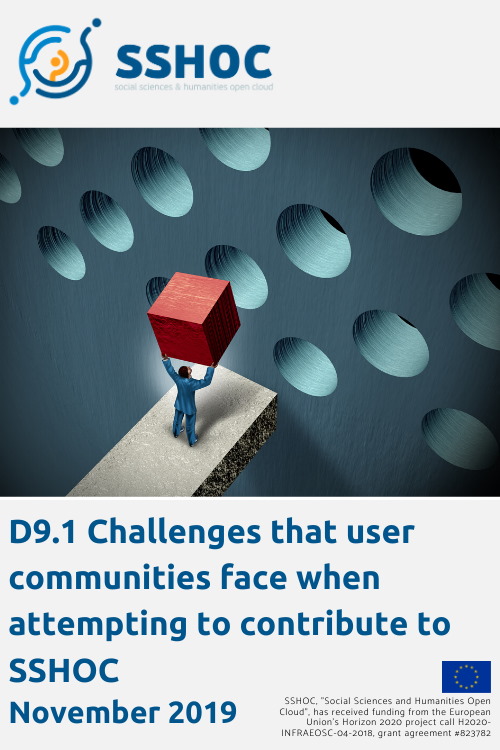
- Social Sciences & Humanities Open Cloud
SSHOC D9.1 Challenges that user communities face when attempting to contribute to SSHOC

Submission date:
18 November 2019
This report analyses obstacles that user- and data-communities and their members are likely to experience when attempting to engage with, make use of the products and services provided by, and contribute to the
evolving EOSC/SSHOC infrastructure. This remit is described in section 1.
The report then analyses (in section 2) the concept of user-communities, in order to subsequently distinguish different kinds of user-communities and different kinds of members. The reason for these distinctions is that
the kinds of obstacles to be experienced cannot be expected to be uniform, but to vary because of the characteristics of communities and members. With respect to user-communities an important difference is
whether they are included in the SSHOC Consortium (many SSH user communities are not, or not yet, yet SSHOC aspires to be also relevant for them). Additional differences relate to their organisational strength. With respect to members of user communities, the most relevant distinction is between ‘leading’ members (who occupy a role or position in the organisations of user communities) and ‘regular’ members.
The report then distinguishes (in section 3) different ways in which user-communities and their members can interact with the evolving EOSC/SSHOC infrastructure, and describes three of such ways: ‘engaging with’
(mainly in the form of attentiveness), which is seen as a first step towards ‘using’ (which consists of drawing on the infrastructure to acquire data, tools, and other products and services for use in research). The third way of interaction consists of ‘contributing to’ (which involves making one’s own research, its data, tools, outcomes and publications available to others via the EOSC/SSHOC infrastructure).
In section 4 a bounded rationality perspective and a socialisation perspective are used to analyse factors that create obstacles for user-communities and their members to productively interact with the EOSC/SSHOC infrastructure. This results in the identification of the following four generic obstacles: (1) unfamiliarity; (2) expense (in terms of money, time, attention and training); (3) low priority (as a consequence of opportunity
costs); and (4) inability (in the form of insufficient relevant skills and competence).
Section 5 discusses how each of these obstacles impinges on different kinds of user-communities and different kinds of their members, a discussion that is summarised in the form of low, medium or high relevance of each of the four identified obstacles for the various kinds of user-communities and members that were distinguished earlier, in section 2.
This deliverable has been accepted by the European Commission on - 03 November 2020
Publication type:
Deliverable
Catalogue:
Ethnic and Migrant Minority Survey Registry
